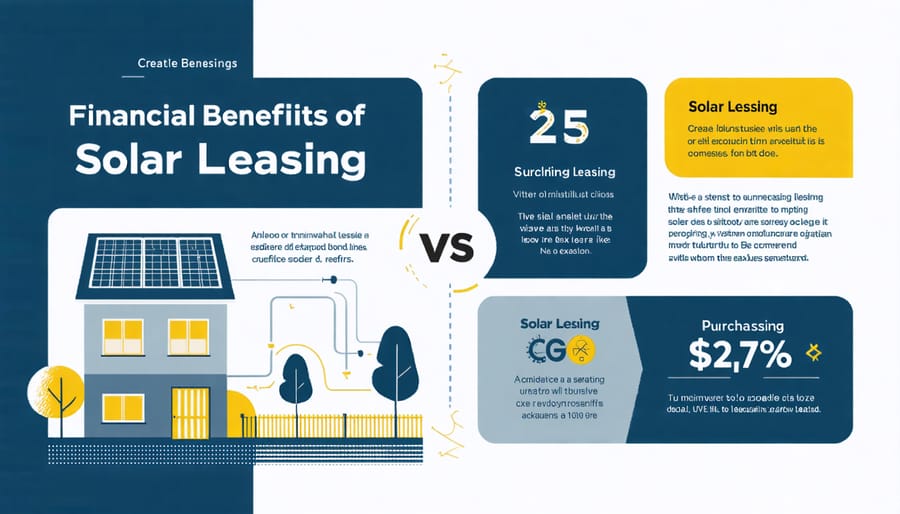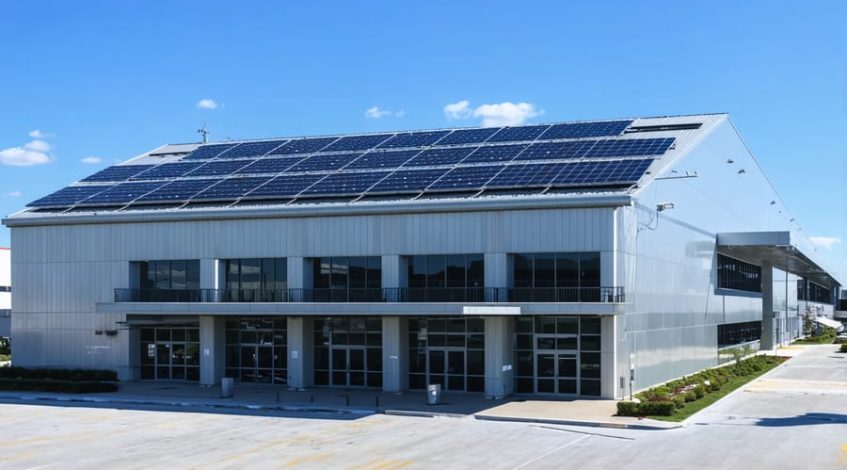Solar panel lease tax credits offer businesses a strategic pathway to reduce operational costs while advancing sustainability goals. Recent federal legislation has expanded these incentives, enabling organizations to claim up to 30% of qualified solar installation costs through specialized leasing arrangements. Unlike traditional solar purchases, leasing programs provide immediate tax advantages while minimizing upfront capital investment.
For facility managers and business owners navigating the complex landscape of renewable energy investments, solar lease tax credits represent a compelling financial opportunity. The structure of these credits allows organizations to benefit from clean energy solutions while maintaining cash flow flexibility. When combined with state-level incentives and depreciation benefits, solar leasing can deliver substantial returns on investment within the first year of implementation.
Understanding the nuances of solar lease tax credits has become increasingly critical as energy costs continue to rise and environmental regulations evolve. Whether managing a small commercial property or overseeing a large industrial facility, these tax incentives provide a practical framework for sustainable energy adoption while optimizing financial performance. Forward-thinking organizations are leveraging these credits to transform energy expenses into strategic assets, positioning themselves for long-term competitive advantage in an increasingly sustainability-focused marketplace.
Understanding Solar Panel Lease Tax Credits

Federal Tax Credit Benefits
The Investment Tax Credit (ITC) represents a significant financial incentive for businesses considering solar panel leasing arrangements. Under current federal legislation, the ITC allows qualifying lessees to claim a tax credit equivalent to 30% of the solar system’s total cost through 2032. This benefit applies to both commercial and industrial installations, making it a powerful tool for reducing initial investment costs.
For leased solar systems, the tax credit structure operates differently than with purchased systems. The solar leasing company, as the system owner, typically claims the ITC directly. However, this benefit is often passed through to the lessee in the form of reduced lease payments, effectively lowering the overall cost of the solar installation.
To qualify for these benefits, the solar lease agreement must meet specific IRS requirements. The system must be new, installed for the first time, and generate electricity for the business property. Additionally, the lease term should be structured appropriately to ensure compliance with IRS guidelines and maximize tax advantages.
Business owners should note that while they may not claim the ITC directly with a lease arrangement, they can still benefit from other tax incentives, including depreciation and state-specific solar incentives. The combination of these benefits, along with reduced energy costs, creates a compelling financial case for solar leasing in commercial applications.
To optimize tax benefits, organizations should work with qualified tax professionals and solar providers who understand the complexities of ITC regulations and can structure lease agreements to maximize available incentives.
State-Specific Incentives
State-level incentives for solar panel leasing vary significantly across regions, complementing federal tax credits to create compelling financial benefits. California leads with its Solar Initiative (CSI) program, offering performance-based incentives and additional tax exemptions for commercial lessees. New York provides robust support through NY-Sun incentives, which can be combined with federal credits to reduce overall leasing costs by up to 60%.
Massachusetts offers its SMART program, providing fixed-rate incentives for businesses leasing solar installations, while New Jersey’s SREC program allows lessees to earn additional income through solar renewable energy certificates. These state programs typically work in parallel with federal incentives, allowing businesses to maximize their return on investment.
Several states also offer property tax exemptions for solar installations, ensuring that improved property values from solar additions don’t result in higher tax assessments. Arizona, Florida, and Texas provide sales tax exemptions on solar equipment leases, further reducing initial costs. It’s crucial for businesses to consult with local tax advisors, as these incentives frequently update and may have specific qualification requirements or caps on benefit amounts.
Lease vs. Purchase: Tax Implications
Financial Benefits of Leasing
Leasing solar panels offers substantial financial advantages that can significantly impact your bottom line. When making solar panel investment decisions, understanding these benefits is crucial for optimal returns.
First, leasing eliminates the need for substantial upfront capital investment, allowing businesses to preserve cash flow for other operational needs. Monthly lease payments are typically lower than current utility bills, resulting in immediate cost savings from day one. These payments are also predictable, facilitating better budget planning and financial forecasting.
The tax implications of solar leasing are particularly advantageous. While lessees cannot claim the federal Investment Tax Credit (ITC) directly, the savings are often passed through via reduced lease payments, as lessors typically claim these credits and transfer the benefits. Additionally, lease payments may be tax-deductible as business expenses, offering further financial advantages.
Many states offer additional incentives for solar leasing arrangements, including property tax exemptions and performance-based incentives. These benefits, combined with reduced energy costs, can result in significant long-term savings. For example, a typical commercial facility might save 20-30% on energy costs through solar leasing while maintaining the flexibility to upgrade as technology improves.
Moreover, maintenance costs are usually covered by the lessor, eliminating unexpected repair expenses and ensuring optimal system performance throughout the lease term.

Take-back Program Considerations
When approaching the end of a solar panel lease term, businesses must carefully consider the tax implications of their chosen exit strategy. The decision between purchasing the system, extending the lease, or removal can significantly impact your tax position. Understanding these implications is crucial for maintaining compliance and optimizing financial benefits.
For system removal, costs may be tax-deductible as a business expense, but this could trigger recapture of previously claimed tax benefits. Companies should evaluate their end-of-lease recycling options and associated costs, as proper disposal can qualify for additional tax incentives under environmental sustainability programs.
If opting to purchase the system at fair market value, the transaction may qualify for depreciation benefits and potentially new tax credits, depending on current legislation. However, the basis for these benefits will typically be lower than a new system installation.
Lease extension agreements often maintain existing tax benefits but may require reassessment of payment structures and eligibility for current incentives. Organizations should consult with tax professionals to review any modifications to lease terms, as these changes could affect the treatment of payments and available credits.
Documentation requirements for all end-of-lease decisions are stringent. Maintaining detailed records of disposal costs, purchase agreements, or lease modifications is essential for defending tax positions during potential audits.
Maximizing Tax Benefits Through Advanced Leasing Programs
Corporate Tax Planning Strategies
Effective corporate tax planning for solar lease tax credits requires a strategic approach that maximizes financial benefits while ensuring compliance with tax regulations. Organizations should begin by conducting a comprehensive analysis of their tax liability and potential credit utilization over the next several years.
To optimize tax benefits, businesses should consider implementing a phased approach to solar lease agreements. This allows for better distribution of tax credits across multiple fiscal years, preventing excess credits that cannot be fully utilized in a single tax period.
Documentation plays a crucial role in tax planning. Maintain detailed records of all lease agreements, payment schedules, and energy production data. These records should clearly demonstrate the business purpose of the solar installation and support the claimed tax credits during potential audits.
Consider establishing a dedicated cost center for solar lease expenses and related tax credits. This practice enables better tracking of financial benefits and simplifies reporting requirements. It also helps in demonstrating ROI to stakeholders and maintaining transparency in financial statements.
Work with qualified tax professionals who specialize in renewable energy credits to develop a comprehensive strategy. They can help identify opportunities for credit carryforward, alternative minimum tax implications, and potential state-level incentives that complement federal tax credits.
Timing is essential in tax planning. Consider implementing solar lease agreements early in the fiscal year to maximize depreciation benefits. This approach provides more flexibility in tax planning and allows for better cash flow management throughout the year.
Regular review and adjustment of tax planning strategies ensure continued optimization as tax laws and business circumstances evolve. Consider conducting quarterly assessments to track credit utilization and adjust strategies as needed.
Documentation Requirements
To successfully claim solar panel lease tax credits, maintaining comprehensive documentation is crucial. The IRS requires specific records to verify eligibility and credit amounts. Essential documents include the signed solar lease agreement, detailed cost breakdowns, and proof of system installation completion. These records should clearly indicate the lease terms, payment schedules, and system specifications.
Business owners must maintain records of all lease payments made during the tax year, along with documentation showing the system’s power generation capacity and actual performance metrics. Through transparent documentation tracking, organizations can effectively demonstrate their compliance with tax credit requirements.
Key documentation requirements include:
– Certification of system eligibility from manufacturer
– Proof of system interconnection with the power grid
– Detailed energy production reports
– Documentation of any state or local incentives received
– Annual maintenance records and inspection reports
– Proof of insurance coverage for the leased system
Store all documentation securely for at least three years after claiming the tax credit. Digital copies should be maintained alongside physical records, with regular updates to reflect system modifications or lease amendments. Consider implementing a dedicated filing system to organize these documents efficiently, ensuring quick access during tax preparation or potential audits.

Case Study: Tax Credit Success Stories
The transformative impact of solar lease tax credits is best illustrated through real-world success stories. Consider the case of Midwest Manufacturing, a medium-sized industrial facility in Ohio that implemented a solar lease program in 2021. By utilizing available tax credits, they reduced their initial investment by 30% and achieved annual energy savings of $75,000, resulting in a positive cash flow from day one of installation.
Another compelling example is Green Valley Grocers, a chain of supermarkets in California. Their strategic decision to lease solar panels across 12 locations yielded remarkable results. Through careful structuring of their lease agreement and maximizing available tax incentives, they secured a 26% tax credit while reducing their carbon footprint. The company reported a 40% reduction in electricity costs within the first year, demonstrating how sustainable solar solutions can deliver both environmental and financial benefits.
The success story of Cedar Ridge Office Park showcases the advantages of commercial solar leasing at scale. This multi-tenant facility in Arizona implemented a 500kW system through a power purchase agreement (PPA) structure. By leveraging tax credits and depreciation benefits, they achieved a 45% reduction in operating costs while providing tenants with clean, reliable energy. The project’s success led to increased property values and higher tenant satisfaction rates.
Small businesses have also reaped significant benefits. Take the example of Family Foods, a local restaurant in Florida. Their solar lease program, combined with available tax credits, resulted in immediate monthly savings of $600 on utility bills. The restaurant allocated these savings to kitchen upgrades and staff training, demonstrating how solar tax incentives can fuel business growth beyond energy costs.
These success stories share common elements: careful planning, strategic use of tax incentives, and partnership with experienced solar providers. The businesses not only achieved significant cost savings but also enhanced their brand reputation as environmental stewards, creating additional value beyond the direct financial benefits of their solar investments.
Solar panel leasing tax credits represent a significant opportunity for businesses to embrace sustainable energy while maximizing financial benefits. By understanding the available tax incentives, companies can make informed decisions that align with both their environmental goals and fiscal responsibilities.
The key takeaway is that solar lease arrangements offer substantial tax advantages, including federal Investment Tax Credit (ITC), depreciation benefits, and state-specific incentives. These benefits can significantly reduce the overall cost of transitioning to solar energy while providing predictable energy expenses for years to come.
To take advantage of these opportunities, businesses should:
1. Conduct a thorough energy audit to determine solar potential
2. Consult with qualified tax professionals familiar with renewable energy incentives
3. Compare multiple solar leasing providers and their offerings
4. Review lease terms carefully, paying special attention to tax credit arrangements
5. Maintain detailed documentation for tax filing purposes
Remember that timing is crucial, as tax incentives may change or phase out over time. Current federal tax credits are set to decrease in the coming years, making it advantageous to act sooner rather than later.
For optimal results, partner with experienced solar providers who understand both the technical aspects of installation and the complexities of tax credit qualification. This ensures your business can fully capitalize on available incentives while implementing a sustainable energy solution that delivers long-term value.
The transition to solar energy through leasing arrangements represents a strategic opportunity to reduce operating costs, enhance sustainability credentials, and benefit from significant tax advantages. Take the first step today by scheduling consultations with solar leasing providers and tax professionals to explore your options.

